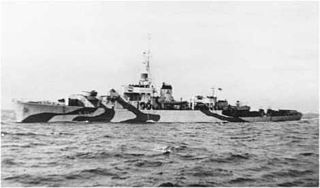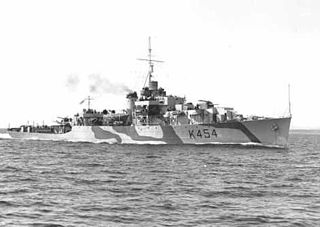
HMCS Antigonish was a River-class frigate that served in the Royal Canadian Navy from 1944–1946 and as a Prestonian-class frigate from 1957–1966. She is named for Antigonish, Nova Scotia. Her photo is featured on the cover of the 1994 album Frigate by the band April Wine.

HMCS Charlottetown was a River-class frigate that served with the Royal Canadian Navy (RCN) during the Second World War. She was the second vessel of the name, HMCS Charlottetown having been a Flower-class corvette that had been sunk earlier in the war. They are unique for being the only two ships to have shared the same pennant number, K 244. She was named for Charlottetown, Prince Edward Island.

HMCS Beacon Hill was a River-class frigate that served in the Royal Canadian Navy (RCN) as an ocean convoy escort during the Second World War. She fought primarily in the Battle of the Atlantic. In 1954 she was converted to a Prestonian-class frigate and served until 1957. She was named for Victoria, British Columbia, but because HMS Victorious was in service with the Royal Navy, the RCN, in an effort to avoid confusion, chose to honour the city by choosing another name associated with it.

HMCS Cape Breton was a River-class frigate that served the Royal Canadian Navy (RCN) during the Second World War. She served primarily as a convoy escort in the Battle of the Atlantic during the war. She was named for Cape Breton Island in Nova Scotia. She was the first to carry her name, HMCS Cape Breton was the second.

HMCS Capilano was a River-class frigate that served with the Royal Canadian Navy during the Second World War. She served primarily as a convoy escort in the Battle of the Atlantic. She is named for Capilino River in North Vancouver, British Columbia. The navy intended to name the ship after North Vancouver, however due to possible confusion with HMCS Vancouver, she was named after the lake.

HMCS Royal Mount was a River-class frigate that served with the Royal Canadian Navy during the Second World War. She was used primarily as an ocean convoy escort in the Battle of the Atlantic. She was named for Mount Royal, Quebec, however due to possible confusion with HMCS Montreal, her name was switched around.

HMCS Chebogue was a River-class frigate that served with the Royal Canadian Navy during the Second World War. She served primarily as an ocean convoy escort in the Battle of the Atlantic. She was named for Chebogue, Nova Scotia. During the war she was torpedoed and declared a constructive loss.

HMCS Grou was a River-class frigate that served with the Royal Canadian Navy during the Second World War. She served primarily as an ocean convoy escort in the Battle of the Atlantic. She was named for Jean Grou, a Roman Catholic martyr from Pointe-aux-Trembles, Quebec. The town's name was considered too long for a warship, so they chose something that was significantly tied to it.

HMCS Lévis was a River-class frigate that served with the Royal Canadian Navy during the Second World War. She served primarily as a convoy escort in the Battle of the St. Lawrence and the Battle of the Atlantic. She was the second ship to bear the name of Lévis, the first being a Flower-class corvette that had been sunk earlier in the war. She was named for Lévis, Quebec.

HMCS New Waterford was a River-class frigate that served with the Royal Canadian Navy during the Second World War and then again from 1958–1966 as a Prestonian-class frigate. She served primarily in the waters around the United Kingdom as a convoy support escort. She was named for New Waterford, Nova Scotia.

HMCS Orkney was a River-class frigate that served with the Royal Canadian Navy as a convoy escort during the Second World War. She was named for Orkney, Saskatchewan. After the war she was purchased and used by the Israeli immigrant movement, then taken over by the nascent Israeli Navy and renamed Mivtah. She was sold by Israel to Ceylon who renamed her Mahasena.

HMCS Port Colborne was a River-class frigate that served with the Royal Canadian Navy during the Second World War. She served primarily as a convoy escort in the Battle of the Atlantic. She was named for Port Colborne, Ontario.

HMCS Prince Rupert was a River-class frigate that served with the Royal Canadian Navy during the Second World War. She served primarily as a convoy escort in the Battle of the Atlantic. She was named for Prince Rupert, British Columbia.

HMCS Runnymede was a River-class frigate that served with the Royal Canadian Navy during the Second World War. She served primarily as a convoy escort in the Battle of the Atlantic. She was named for York, Ontario, however due to possible confusion with HMCS West York, her name reflects a connection with that community.

HMCS Springhill was a River-class frigate that served with the Royal Canadian Navy during the Second World War. She served primarily as a convoy escort in the Battle of the Atlantic, mainly in the Battle of the St. Lawrence. She was named for Springhill, Nova Scotia.

HMCS Kirkland Lake was a River-class frigate that served with the Royal Canadian Navy during the Second World War. She served primarily as a convoy escort in the Battle of the Atlantic. She was named for Kirkland Lake, Ontario.

HMCS Stone Town was a River-class frigate that served with the Royal Canadian Navy during the Second World War. She served primarily as a convoy escort in the Battle of the Atlantic. She was named for St. Marys, Ontario, however there was already a ship by that name within the Commonwealth navies so they chose the nickname of the town for its representation. After the war she was re-purposed as a weather ship for use by the Department of Transport of Canada.

HMCS Strathadam was a River-class frigate that served with the Royal Canadian Navy during the Second World War. She served primarily as a convoy escort in the Battle of the Atlantic. She was named for Strathadam, New Brunswick. After the war she was made part of the nascent Israeli Navy as the renamed Misgav.

HMCS St. Stephen was a River-class frigate that served with the Royal Canadian Navy during the Second World War. She served primarily as a convoy escort in the Battle of the Atlantic. She was named for St. Stephen, New Brunswick.

HMCS Waskesiu was a River-class frigate of the Royal Canadian Navy. The frigate served as a convoy escort in the Battle of the Atlantic during the Second World War. It was the first frigate constructed and commissioned into the Royal Canadian Navy. Following the war, the vessel was sold to India where it was renamed Hooghly. Named after the town of Prince Albert, Saskatchewan, there was already a warship named "Prince Albert". The Royal Canadian Navy then named the ship after the town closest to Prince Albert National Park.



















